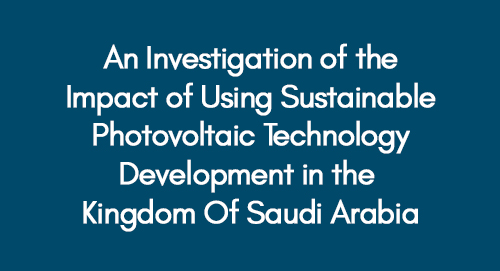
Patient Satisfaction Dissertation
December 25, 2020
The Importance of Health and Safety in Today’s Construction Industry
January 12, 2021A study is looking at how using eco-friendly solar power technology is changing things in Saudi Arabia. They want to understand how this country, which has a lot of oil, is starting to use more renewable energy. This research can help the people who make the rules and the companies that work with energy in Saudi Arabia. It will help them decide how to use energy in the future.
Chapter 1: Introduction
In this industrial era, water and energy are the two most important requirements for the sustainability of the human race, and nations around the globe are addressing this issue. No matter how developed or populous a nation is, having to develop means of producing energy for their people and maintaining the environment's safety holds pivotal importance. The Kingdom of Saudi Arabia has one of the largest concentrated solar power (CPS) and photovoltaics resources. The country is utilising these resources to produce high direct normal irradiation (DNI) that can help it generate energy from renewed and highly sustainable resources (Kicp, 2009).
Development of Sustainable Homes Through Renewable Energy Sources
The basic purpose behind this practice is to reduce the consumption of hydrocarbons currently being used by the country in generating electricity and desalting seawater. In addition, the Kingdom of Saudi Arabia is an attractive market for foreign investors when it comes to investing in the energy sector. The photovoltaics companies are drawn to the nation because the energy cost is relatively low. Therefore, they find attractive business conditions in this Kingdom (Santander, 2015).
However, many of the potential investors, as well as the practitioners, require a strong domestic market to operate. Considering the present condition of Saudi Arabia, various researchers have suggested that in the coming five years, the solar energy sector will become one of the major pillars in the industries of Saudi Arabia, with an estimation of US$10 billion in sales and more than 50% of export share (Huraib, 2014).
Aims and Objectives
The purpose and the primary aim of the current research are also to study the effect and potential of photovoltaic technology in the economic and industrial sectors of Saudi Arabia and how they can play their role in shaping the sustainable future of the nation. The motivation for this research also comes from the fact that sustainable energy resources are considered for the future energy sector in years to come, and its potential in the Kingdom of Saudi Arabia must be investigated to review its potential in terms of economic and sustainability parameters.
Explore the Case of Tesla Merger with Solar City
- To study the use of concentrated solar power (Cps) and photovoltaics technology in the energy sector of Saudi Arabia.
- To study the impact of Photovoltaics in producing high direct normal irradiation by the kingdom in generating clean and sustainable energy sources.
- To study the impact of the increasing trend in using photovoltaics on foreign investment in Saudi Arabia.
- To study the impact of sustainable photovoltaic technology development in the economic sector of Saudi Arabia.
From the above-mentioned objectives, the following research questions have been developed, which are aimed to be addressed in this study:
How is the Saudi Government utilising concentrated solar energy and photovoltaics technology to increase its direct normal irradiation to generate clean and sustainable energy resources?
What will be the impact of the use of photovoltaic technology on the foreign investments and economic productivity of Saudi Arabia?
Chapter 2: Review of Literature
Solar energy is considered a clean and safe energy source as it does not risk human life and the environment. Its utilization helps decrease various energy-related major concerns, such as the generation of pollution from the coal or petroleum industry (Taleb & Sharples, 2011).
Photovoltaic (PV) panels are currently used for various purposes, such as in water pumps to pump water for domestic use, such as watering crops or animals. Such photovoltaic panels can be installed or mounted anywhere to supply water to an area, even if there is no electric grid nearby. They are environment-friendly as they do not consume fuel or burn fossils to generate energy. This system requires minimum skilled employees after its operation, and they are also very cost-effective when it comes to maintaining them. However, the use of these systems has great potential. It can be utilised for higher energy requirements of the modern era, given that proper infrastructure is developed to extract this sustainable form of energy (Yasser Al-Saleh & Upham, 2008).
The Kingdom of Saudi Arabia has been blessed in a way that its geographical location allows it to receive intense solar radiation for long hours because of its vast open lands. According to Rehman et al., the time sunshine received by the Saudi Kingdom varies between 7.4h to 9.4h per day with a mean of 8.98h, accumulating to a total of 3245h of sunshine per year. Residencies are spread all over the kingdom. However, Dhahran, Riyadh, Jeddah, Gurian and Nejran are the most populated areas. This is primarily because these cities are connected with the national grid station of the country and highway networks. However, many small cities are currently not connected with the national grid stations, depend on diesel-generated power stations for power supply, and have independently isolated grids. Pumping water in these areas is a significant challenge for the Kingdom of Saudi Arabia. Therefore, the Kingdom is utilising PVPSs in these areas to provide advancements in sustainable development to carry out these activities. This technology brings an affordable and maintainable power generation system to Saudi Arabia. Development in this area is actually increasing the living standard of people living in remote locations (Huraib, 2014).
The current energy requirements in Saudi Arabia indicate that the nation’s demand for electricity will exceed from 40GW to 120GW by 2028. This, in turn, increases the utilisation of hydrocarbons from 3 million barrels to 8.3 million barrels. In addition, the water demand also increases with the increase in population. Therefore, the Kingdom of Saudi Arabia is subjected to introducing renewable energy to meet the energy demands and reduce the utilisation of hydrocarbons (Lahn & Stevens, 2011). The key initiative was the use of concentrated solar energy and photovoltaic panels. However, the country's climate conditions, such as high temperatures and dust, bring serious challenges, such as temperature and dust effect on these solar energy plants (Khan, 2014).
Photocatalytic Treatment of Wastewater
Despite meeting the energy needs, the Kingdom is also ideal and offers very attractive conditions for foreign investment in the energy field. The main reason behind this investment is that the energy costs are really low in Saudi Arabia (Hurain, 2016). Photovoltaics companies involved in silicon and ingot/wafer production are attracted to the Kingdom and consider this region profitable for conducting business (Yasser Al-Saleh & Upham, 2008). However, they require a strong domestic solar market for their business to operate efficiently, which can be made possible through motivating / advertising / informing the end-users and by introducing various schemes such as CO2 reduction certificates to attract these companies to invest in it.
This increased investment in the energy sector has the potential to support the country in decreasing its dependence on oil and aids in creating a solar-based, environmentally responsible economic environment. This makes Saudi Arabia an ideal location to attract silicon and wafer projects. In addition, it will also become a good market for final photovoltaic projects. A detailed discussion on how this photovoltaic technology will affect the Saudi environment in the long term and how its domestic market can be developed (such as through effective communication, partnering with local stakeholders, governmental support, etc.) platforms will be discussed in detail later in the research.
Chapter 3: Methodology
The research design opted for the study, and different techniques that will be utilized to gather research data will be discussed in the methodology chapter. The researcher will describe the means and strategies to obtain primary and secondary data for the research. This chapter will consist of an explanation of the following;
- Research Methodology
- Research Sampling Techniques
- Tools to be used for Data Collection
- Research Limitations
- Methods to be used for Data Analysis and
- The Philosophical Approach
All these parameters will ensure that the researcher can obtain sufficient data so that the researcher’s aims, as well as all the objectives, are achieved. It might be possible that primary research and data sources may not be required for this research, and extensive secondary sources are available to extract/process the required data.
Chapter 4: Findings & Analysis
The most important findings and results of this research obtained through the literature review and statistical analysis will be presented. Emphasis will be made on ensuring that the findings of this research justify the research objectives and are in context with similar studies carried out in the same field. There might be a chance that some of the findings will not justify the earlier hypothesis about the results. This may result due to the difference in characteristics of the research sample, such as demographic information or research design. However, the aim of the researcher is to present the results in accordance with research aims and objectives.
Chapter 5: Discussions & Conclusions
A discussion and conclusion will be presented in the final section of this paper. Here, the researcher will discuss the research findings and give his views and opinions about the results obtained and the extracts of the literature reviewed. In addition, the researcher will discuss these findings in the light of authentic research resources and support his findings by relating them to other studies. The discussion and conclusion chapter will clearly summarize the impact of sustainable photovoltaic technology development in Saudi Arabia.
References
Huraib, F.B., 2014. Islamic World Science Net. [Online] Available at: http://www.icpsr.org.ma/?Page=showInstitute&InstituteID=ERI21&CountryID=saudiarabia [Accessed 16 January 2016].
Hurain, S., 2016. Royal Embassy of Saudi Arabia. [Online] Available at: https://www.saudiembassy.net/about/country-information/energy/ [Accessed 16 January 2016].
IEA, (2011). Solar Energy Perspectives, IEA/OECD
Khan, S., 2014. Energy Issues And Policies. A Quarterly Journal For Debating Energy Issues And Policies, IX(96).
Kicp, 2009. "Saudi Arabia Solar Energy" Manufacturing and Technology. Riyadh: KAUST Industry Collaboration Program (KICP).
Lahn, G. & Stevens, , 2011. Burning Oil to Keep Cool The Hidden Energy Crisis in Saudi Arabia. Chatham House.
Mehta, S. and P. Maycock (2010). The PV Supply Chain: Manufacturing, Technologies, Costs, Greentech Media Research and PV Energy Systems
Nature Photonics (2010), Future Perspectives of Photovoltaics, Proceedings of the Conference, Nature Publishing Group.
Santander, 2015. Trade Portal. [Online] Available at: https://en.santandertrade.com/establish-overseas/saudi-arabia/foreign-investment [Accessed 16 January 2016].
Taleb, H.M. & Sharples, 2011. Developing sustainable residential buildings in Saudi Arabia: A case study. Applied Energy, (88), pp.383-91.
Yasser Al-Saleh & Upham, P., 2008. Renewable Energy Scenarios for the Kingdom of Saudi Arabia. Manchester: Tyndall Centre for Climate Change Research.
Get 3+ Free Dissertation Topics within 24 hours?




























